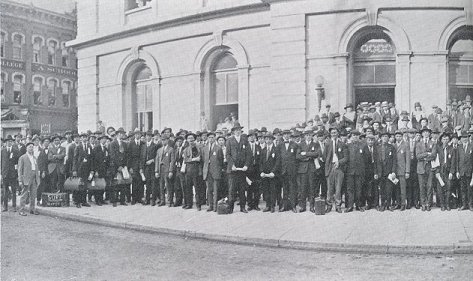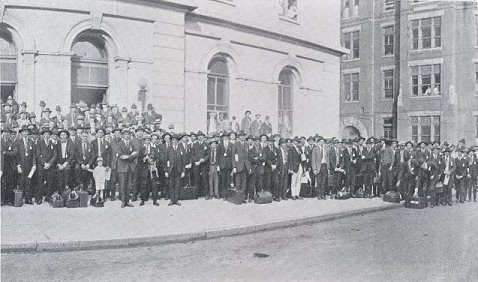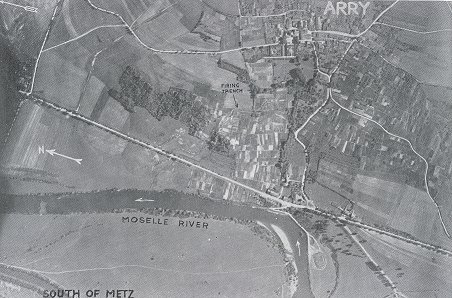
Second Corps Artillery Park
Pursuant to a special call issued by the War Department for an additional 55,000 men, 280 young men of Knoxville and Knox County were formally mustered into the service of the United States on Tuesday, May 21, 1918. Exactly two months later a large proportion of these men steamed into the harbor of Brest, France, as members of the various units of Second Corps Artillery Park. Before the signing of the armistice, this Knox County contingent had act actively participated in four of the greatest battles of the war -- a record achieved by few units of the American Expeditionary Forces and excelled by still fewer.
 |
| "Ready
for Camp" These photos are of the 280 men, inducted into service May 24, 1918, at Knoxville. It was the largest single group inducted into service from Knox County through the draft call, and they were given a great send-off at the federal building and a parade to the railroad station. Most of them were assigned later to the Second Corps Artillery Park. |
 |
The Second Corps Artillery Park was known as an artillery auxiliary unit. At no time was it attached to any division, but was placed where its services were most needed. This meant its labor scarcely lapsed from the time the unit landed in France July 21, 1918, until its broken remnants set sail for home in July, 1919. From August 10-15, the Second Corps Artillery Park served with the American forces in the latter part of the Aisne-Marne offensive, which comprised all fighting in the famous Chateau-Thierry district and is commonly known as the Second Battle of the Marne. September 12-15 it was engaged with the American First Army in the St. Mihiel drive. For weeks previous to this battle, however, the organization worked tirelessly on the Toul front in preparation for the offensive. September 17 to October 17 it was attached to the Second French Army and actively engaged in the Oise-Aisne offensive. October 17 to November 11 it did valiant work with the Fifth Army Corps of the American First Army in the historical battle of the Argonne Forest. Three times the organization was cited by the ranking generals of the American and French armies for valuable results accomplished during these offensives.
Boarding a special train at Knoxville Friday, May 24, 1918, after one of the most patriotic and enthusiastic demonstrations ever accorded a departing unit, the men reached Fort Thomas, Kentucky, the following day, were quickly examined and outfitted, and at 10:30 o'clock Sunday morning started for Camp Jackson, South Carolina, as field artillery replacements. Reaching Camp Jackson early Monday evening, they were assigned to a field artillery replacement depot and during that week received their first training in the rudiments of soldiery. However, their experience as field artillery replacements was destined to be of short duration.
Saturday, June 1, the men were ordered to move to another part of the camp and there were assigned to the new organization known as the Second Corps Artillery Park. This unit, destined to be a motorized outfit, was composed of six truck companies of 140 men each and one company of 250 men known as the Park Battery, making a total of approximately 1,100 men, and comprising a majority of the 280 Knox County boys and about 100 from Louisville, Kentucky. Practically the entire remainder of the new unit hailed from Ohio, Pennsylvania, Rhode Island, Massachusetts and Maine.
The regiment was commanded by Lieutenant-Colonel H. H. Rogers, of New York. Knoxville and Louisville men were assigned entirely to Companies A, B and the Park Battery. The original duties of the organization in the battle area was to repair and replace disabled artillery pieces, but, after reaching France, the work assigned to the six truck companies was almost wholly that of hauling ammunition. The Park Battery was placed in charge of various ammunition depots and of loading and unloading trucks, a gruelling labor continually beset by the danger of enemy artillery and aeroplane attacks.
After one month of intensive military training, the Second Corps Artillery Park entrained July 1 for Camp Stuart, Newport News, Virginia. The organization was re-outfitted, received its final overseas examination and early on the morning of July 10 boarded the former Pacific liner Matsonia, which was accompanied by four other transports and escorted by two torpedo boat chasers. On July 13, they were joined by six transports, a cruiser and two destroyers that had embarked from the port of New York. Reaching the war zone July 18, all men were required to assemble at their respective life rafts at 7:30 o'clock each evening and remain there until dark -- about 10:30 o'clock in that latitude during the summer. They were assembled there again at 2:30 o'clock in the morning and remained until breakfast, such precautions being taken because of the likelihood of submarine attack during either twilight or dawn. However, the voyage was made wholly without incident and the dawn of July 21 brought the joyful sight of the dim outlines of Brest, France.
After enduring the rain, mud, and flies of the celebrated Pontanazen Barracks until Wednesday morning, July 24, the men boarded a train that was to carry them to their work on the battle front. After riding 22 hours, however, they awakened to find themselves once more in Brest, a change in orders having turned them about and brought them again to their starting point. For the next week the members of the regiment were used on the docks of Brest as stevedores. On August 1, part of the men were ordered to Havre and Bordeaux for trucks, while the remainder started overland in trucks that were to be part of the regiment's equipment and driven by its own men. Friday, August 9, the overland contingent, after traveling 425 miles, reached the destroyed village of Mont St. Pere, nine kilometers east of the famous city of Chateau-Thierry and situated on the north bank of the beautiful Marne River. Here the remainder of the regiment was awaited and to the east of Mont St. Pere the first work in the battle areas was done. The fighting in this vicinity was known as the Aisne-Marne offensive.
Wednesday, August 14, camp was broken and, with its 167 steel-bodied ammunition trucks, the regiment traveled to a point seventeen kilometers west of Chateau-Thierry. There it remained until the following Tuesday, when once more a long trip overland was started which ended near the city of Toul, August 24. After three days of work towing artillery and transporting French troops, the regiment moved its camp into a dense forest several miles north of Toul and only a short distance from the German front lines. During the stay here the men received their first real taste of actual warfare. Continually beset by the dangers of artillery and aeroplane fire, ammunition was hauled nightly for two weeks in pitch darkness over dangerously slippery roads, heavy with war traffic of all kinds. On the afternoon of August 29, two well-placed German artillery projectiles touched off an ammunition dump several acres in area, which was maintained by the organization, and to which its trucks had been hauling shells. Two terrific explosions rocked the earth and the sound of bursting shells continued all through the night. Fortunately, no one was hurt.
 During
the great St. Mihiel offensive which followed on September 12, many of
the trucks continued to supply the big guns with ammunition all through
the night of the opening attack. The following day a hundred Second
Corps Artillery Park trucks loaded with shells started a slow trail in
the wake of the swiftly advancing Yanks. Over roads blown to atoms
by artillery fire and through a maze of traffic, travel was slow, indeed,
and it was the evening of September 15 before they reached a point southwest
of Metz, unloaded and returned to camp. This ended the work in the
St. Mihiel offensive.
During
the great St. Mihiel offensive which followed on September 12, many of
the trucks continued to supply the big guns with ammunition all through
the night of the opening attack. The following day a hundred Second
Corps Artillery Park trucks loaded with shells started a slow trail in
the wake of the swiftly advancing Yanks. Over roads blown to atoms
by artillery fire and through a maze of traffic, travel was slow, indeed,
and it was the evening of September 15 before they reached a point southwest
of Metz, unloaded and returned to camp. This ended the work in the
St. Mihiel offensive.
[Photo at right - "Close to Metz: Aeroplane photograph of town of Arry, on the Moselle River, with defensive fortifications."] September 17 the regiment again broke camp and moved to the village of Lavoye, twenty kilometers southwest of the devastated city of Verdun. After a short stay there, headquarters were moved to Fleury-sur-Aire, where for the next thirty days the regiment hauled ammunition for the Second French Army, to which it had been attached for the Oise-Aisne offensive. The work of the companies was done principally in the vicinity of Verdun. This was a month of severe hardships, of work by day and by night.
The regiment was relieved from duty with the Second French Army on October 17 and immediately assigned to the Fifth Army Corps of the American First Army. The battle of the Argonne Forest was then in full swing and, day after day, night after night, the companies of the regiment were constantly on the road hauling ammunition to our batteries of artillery which were slowly blasting a way forward for the infantry. Often times these trips were of sixty to seventy-two hours duration and were always made under continuous shell fire and unspeakable hardships. Rain fell almost constantly and the trucks, being coverless, gave no protection from the constant downpour.
By November 4 the American army had advanced so far north that it became necessary to move camp near the one-time village of Very, and finally to the village of Gesnes, about 35 kilometers northwest of the city of Verdun and in the very heart of the upper Argonne. During the last stages of the Meuse-Argonne drive many Second Corps boys dauntlessly ran their trucks through shell fire in plain view of the enemy gunners, and on one occasion a few trucks outdistanced the infantry and unloaded cases of shells at the edge of the village of Beauclaire while the Germans yet occupied the town. One detachment of Second Corps trucks advanced with the artillery to the edge of the city of Sedan. Their forward movement was only stopped by the signing of the armistice.
All kinds of rumors were circulated after November 11 as to what would be done with the Second Corps Park. They ranged from the statement that the regiment would go into Germany as a part of the Army of Occupation, to the report that it would return immediately to parade in Washington on Christmas day. What it did do for the next two months was to haul salvage of every sort and description from off the battlefields to the numerous points of concentration. The greater part of this work lay on the old Verdun battlefield, a devastated area so wasted, so dead, so barren after a four-year scourge of hell-fire that it had become a combined desert and charnel house. For awhile the hauling of hand grenades was the chief occupation, but after one truck load blew up, the regiment was relieved from further hauling of these dangerous little missiles.
Finally, orders came to depart and on January 20 the Second Corps Park entrained at Dun-sur-Meuse for Brest, which was reached January 23 after sixty-eight hours of travel in box cars too crowded to lie down and with the weather very wintry. After two weeks of suspense, the regiment became a skeleton organization of 76 men and the remainder transferred to Brest Casual Companies 239, 240, 241, 242, and 243. As casual companies, some men were used as truck drivers, some as military police, others as stevedores and mechanics, while others drew special duty with the Motor Transport Corps. This lasted until May, 1919, when all were relieved, supposedly to depart for home. However, after three weeks' labor with pick and shovel, building a railroad, all were restored to their original status and once more took up the old duties. Early in July, though, the glad day finally arrived when the last member of the organization bade a final farewell to the shores of France and soon arrived home after one year's foreign service well done.
[ Return to Knox County Genealogy Military Page ]
[ Return to Knox County Genealogy Main Page ]
Except as noted, all HTML code and graphics in the URL path [http://www.knoxcotn.org/military/wwi/] were created by and copyrighted 2001-2003 to Billie R. McNamara. All rights reserved. Please direct all questions and comments to Ms. McNamara.This page was last updated January 2, 2004. Visitor